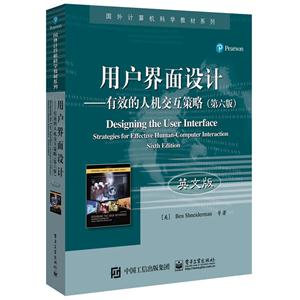用户界面设计-有效的人机交互策略-(第六版)-英文版
本书特色
[
(1)在设计方法中引入了更多的案例研究。(2)重新调整了对社会媒体参与和用户生成内容部分的介绍,尤其是来自移动设备的部分。(3)对本书的每个章节都进行了大量的校订,修改了所有插图,大幅更新了参考文献。
]
内容简介
[
紧跟人机交互变革的脚步很困难。本书每一版刚出版不久,更新的要求就接踵而至。该领域的扩展促使本书前三版的作者Ben Shneiderman求助于其长期、重要的研究伙伴Catherine Plaisant,以合著本书的第四版和第五版。此外,Maxine S. Cohen和Steven M. Jacobs对本书的早期版本有长期的教学经验,他们为所有读者和教师提供了提高书的内容质量的新观点。
]
作者简介
[
Ben Shneiderman,美国知名专家,长期从事用户界面设计的教学与研究工作,发表论文多篇,出版图书多部,在界面设计领域成果丰硕。
BEN SHNEIDERMAN (http://www.cs.umd.edu/~ben) is a Distinguished
University Professor in the Department of Computer Science, Founding Director
(1983-2000) of the Human-Computer Interaction Laboratory (http://www
.cs.umd.edu/hcil/), and a Member of the UM Institute for Advanced Computer
Studies (UMIACS) at the University of Maryland. He is a Fellow of the AAAS,
ACM, IEEE, NAI, and SIGCHI Academy and a Member of the National Academy of
Engineering, in recognition of his pioneering contributions to human-computer
interaction and information visualization.
]
目录
PART 1 INTRODUCTION 2CHAPTER 1 Usability of Interactive Systems 41.1 Introduction 61.2 Usability Goals and Measures 131.3 Usability Motivations 151.4 Goals for Our Profession 20CHAPTER 2 Universal Usability 342.1 Introduction 362.2 Variations in Physical Abilities and Physical Workplaces 372.3 Diverse Cognitive and Perceptual Abilities 392.4 Personality Differences 402.5 Cultural and International Diversity 412.6 Users with Disabilities 442.7 Older Adult Users 472.8 Children 492.9 Accommodating Hardware and Software Diversity 52CHAPTER 3 Guidelines, Principles, and Theories 563.1 Introduction 583.2 Guidelines 583.3 Principles 643.4 Theories 80PART 2 Design PROCESSES 96CHAPTER 4 Design 984.1 Introduction 1004.2 Organizational Support for Design 1024.3 The Design Process 1054.4 Design Frameworks 1114.5 Design Methods 1154.6 Design Tools, Practices, and Patterns 1234.7 Social Impact Analysis 1294.8 Legal Issues 131CHAPTER 5 Evaluation and the User Experience 1385.1 Introduction 1405.2 Expert Reviews and Heuristics 1435.3 Usability Testing and Laboratories 1475.4 Survey Instruments 1595.5 Acceptance Tests 1645.6 Evaluation during Active Use and Beyond 1655.7 Controlled Psychologically Oriented Experiments 171CHAPTER 6 Design Case Studies 1806.1 Introduction 1826.2 Case Study 1: Iterative Design Evaluation of Automated Teller Machines (ATMs) 1836.3 Case Study 2: Design Consistency at Apple Computer 1866.4 Case Study 3: Data-Driven Design at Volvo 1886.5 General Observations and Summary 191PART 3 INTERACTION STYLES 194CHAPTER 7 Direct Manipulation and Immersive Environments 1967.1 Introduction 1987.2 What Is Direct Manipulation? 1997.3 Some Examples of Direct Manipulation 2067.4 2-D and 3-D Interfaces 2167.5 Teleoperation and Presence 2197.6 Augmented and Virtual Reality 224CHAPTER 8 Fluid Navigation 2388.1 Introduction 2408.2 Navigation by Selection 2428.3 Small Displays 2558.4 Content Organization 2588.5 Audio Menus 2638.6 Form Fill-in and Dialog Boxes 264CHAPTER 9 Expressive Human and Command Languages 2769.1 Introduction 2789.2 Speech Recognition 2799.3 Speech Production 2909.4 Human Language Technology 2919.5 Traditional Command Languages 295CHAPTER 10 Devices 30010.1 Introduction 30210.2 Keyboards and Keypads 30410.3 Pointing Devices 31010.4 Displays 328CHAPTER 11 Communication and Collaboration 34811.1 Introduction 35011.2 Models of Collaboration 35411.3 Specific Goals and Contexts 36011.4 Design Considerations 368PART 4 DESIGN ISSUES 384CHAPTER 12 Advancing the User Experience 38612.1 Introduction 38812.2 Display Design 38912.3 View (Window) Management 39512.4 Animation 40112.5 Webpage Design 40312.6 Color 40612.7 Nonanthropomorphic Design 41212.8 Error Messages 416CHAPTER 13 The Timely User Experience 42613.1 Introduction 42813.2 Models of System Response Time (SRT) Impacts 43013.3 Expectations and Attitudes 43413.4 User Productivity and Variability in SRT 43613.5 Frustrating Experiences 438CHAPTER 14 Documentation and User Support (a.k.a. Help) 44614.1 Introduction 44814.2 Shaping the Content of the Documentation 44914.3 Accessing the Documentation 45514.4 Reading from Displays versus Reading from Paper 46014.5 Online Tutorials and Animated Demonstrations 46514.6 Online Communities and Other Avenues for User Support 46814.7 The Development Process 470CHAPTER 15 Information Search 47615.1 Introduction 47815.2 Five-Stage Search Framework 48215.3 Dynamic Queries and Faceted Search 49215.4 Command Languages and “Natural” Language Queries 49715.5 Multimedia Document Search and Other Specialized Search 49815.6 The Social Aspects of Search 502CHAPTER 16 Data Visualization 50816.1 Introduction 51016.2 Tasks in Data Visualization 51116.3 Visualization by Data Type 51916.4 Challenges for Data Visualization 527AFTERWORD Societal and Individual Impact of User Interfaces 536A.1 Future Interfaces and Grand Challenges 538A.2 Ten Plagues of the Information Age 542Name Index 549Subject Index 555Credits 573
封面

书名:用户界面设计-有效的人机交互策略-(第六版)-英文版
作者:本.施耐德曼
页数:596
定价:¥89.0
出版社:电子工业出版社
出版日期:2017-06-01
ISBN:9787121315077
PDF电子书大小:114MB 高清扫描完整版
